
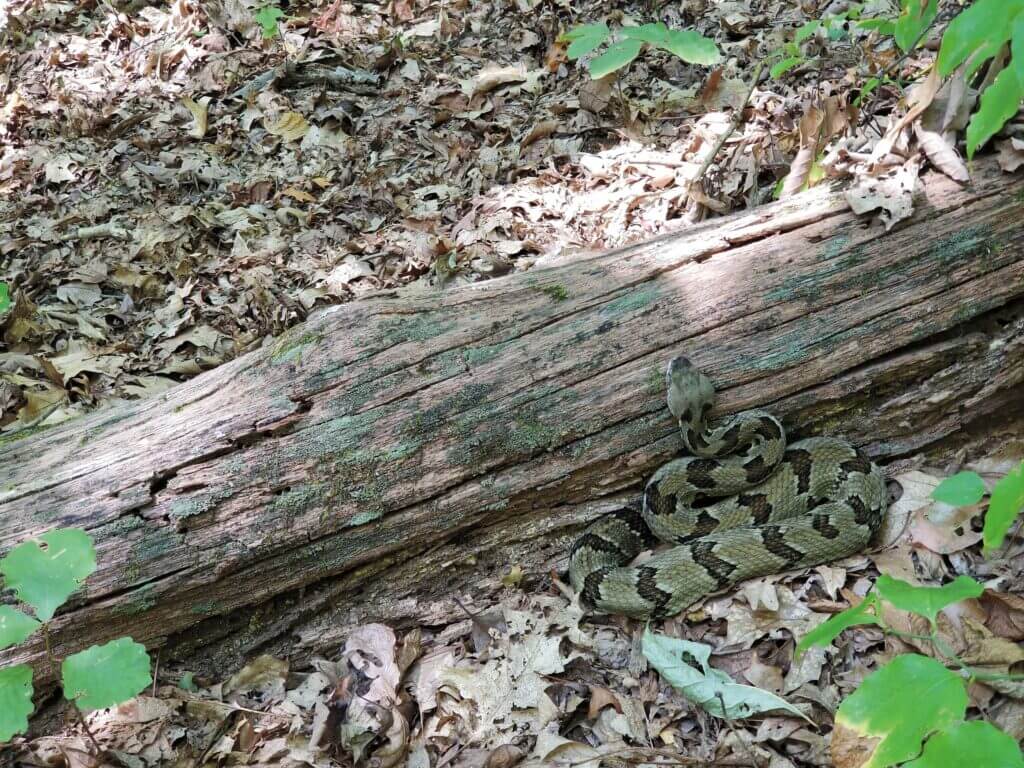
Living harmoniously with our state reptile.
This story was originally published in the May 2020 issue of Wonderful West Virginia. To subscribe, visit wonderfulwv.com.
written by Marsha B. Wassel
photographed by Elizabeth Johnson
West Virginia’s rushing rivers, rugged mountains, and timbered lands beckon residents to explore. While traversing her trails, streams, and forests, it’s wise to remember that this is rattlesnake country. It always has been and, hopefully, through the efforts of the state’s Division of Natural Resources, always will be.
The venomous timber rattlesnake, Crotalus horridus, is a revered animal in American history. It was one of the earliest symbols of independence of the American colonies, and the reverence continued when the snake was named West Virginia’s state reptile in 2008. It remains a conservation priority for DNR and the agency is currently developing a conservation plan to inform people about the important role this misunderstood animal plays in our ecosystem.
Understanding Rattlesnakes
Most people who enjoy outdoor recreation in West Virginia have probably been near a rattlesnake and never knew it. “Timber rattlesnakes are timid animals,” says Kevin Oxenrider, DNR Amphibian and Reptile Program Lead. “They are also ambush predators, not active foragers, and wait quietly for their prey to scurry by. People are a threat and, if given the chance, rattlesnakes will hide or go underground when approached.”
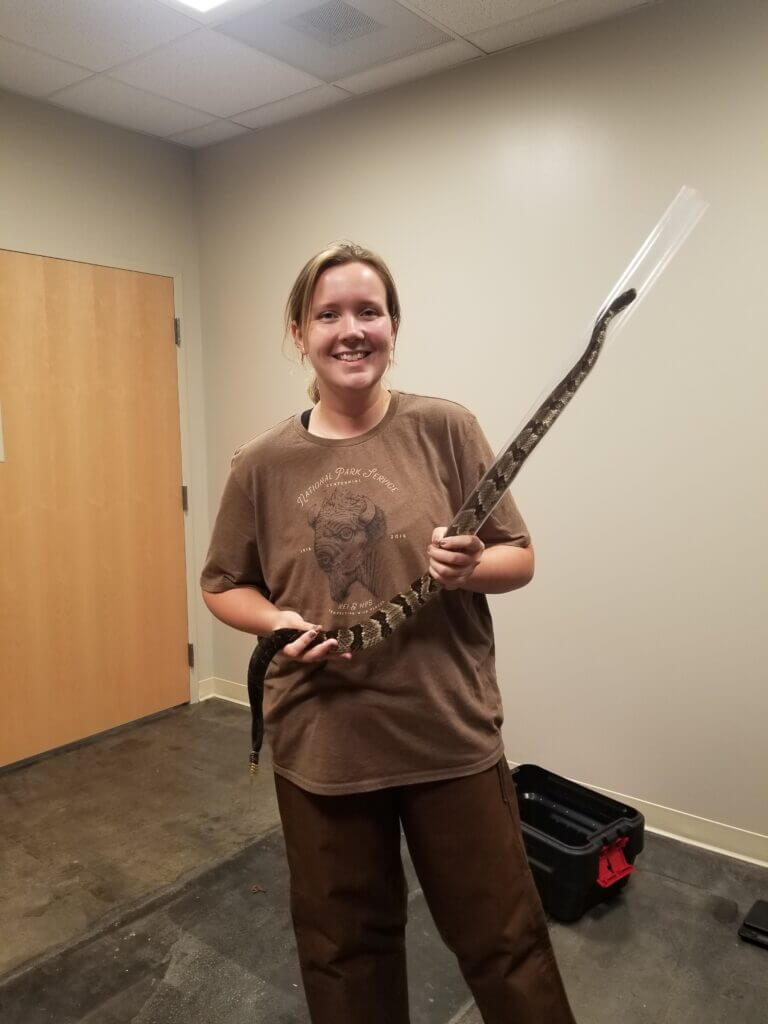
Elizabeth Johnson is a Marshall University biological sciences graduate student from Carlisle, Kentucky. She is working with Waldron on timber rattlesnake studies taking place at Coopers Rock and Kanawha State Forests. Once it enters the thick plastic tube, the snake will be measured, weighed, probed to determine sex, and equipped with a radio transmitter. 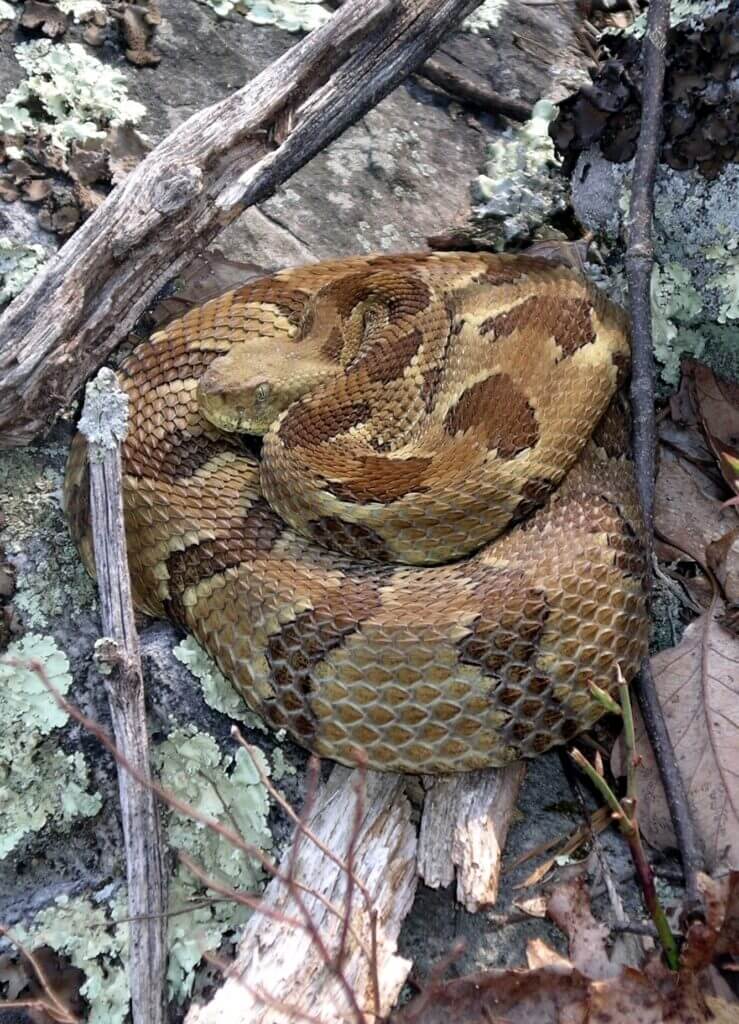
A timber rattlesnake has dark traverse chevron bands on a gray, yellow, black, or brown body color.
Rattlesnakes may stay very still, blending in with their surroundings, and only shake their rattles if people get too close—a clear warning to back off. These animals have a fight or flight instinct, just like humans do, and are only aggressive when they’re attacked and have no escape route. They always prefer to flee, and space is the best thing to give them.
Our Ecosystem Partner
Timber rattlesnakes play an important role in maintaining the fragile balance of nature. “The idea of life without rattlesnakes is the more terrifying thing,” Oxenrider says. They have their own ecosystem function and service, which has an important connection to human health: A large part of the animal’s food supply includes rodents, particularly mice and chipmunks, that reproduce rapidly and carry Hantavirus Pulmonary Syndrome and Lyme disease. By keeping the numbers of these rodents in check, rattlesnakes reduce the risk of these diseases being passed to people.
Rattlesnakes also play a critical role in forest regeneration by consuming animals that damage young forest seedlings and deplete the supply of acorns and other nuts.
A Citizen Science Project
The DNR recently completed a two-year survey to better understand this reptile’s distribution. “Timber rattlesnakes, historically, were found throughout the eastern states from Maine to Florida and westward to Missouri and Texas, but their numbers have declined. In some places, they’ve disappeared,” Oxenrider says. He points to habitat loss and persecution as the main causes, but the agency wanted to find out what was really happening here in West Virginia. Roughly 78 percent of the state is forest, which is prime habitat for rattlesnakes. Their conservation is everyone’s responsibility.
From January 2017 through December 2019, DNR encouraged citizens to submit timber rattlesnake observations to the agency’s website for each snake seen, including the date, location, and a photo. Scientists working on the project believed that the timber rattlesnake was a good subject for a citizen science project because it’s the only rattlesnake in the state and because it has a striking yellowish-greenish pattern with dark bands that is easy to identify from a distance—where you want to be when you come across one.
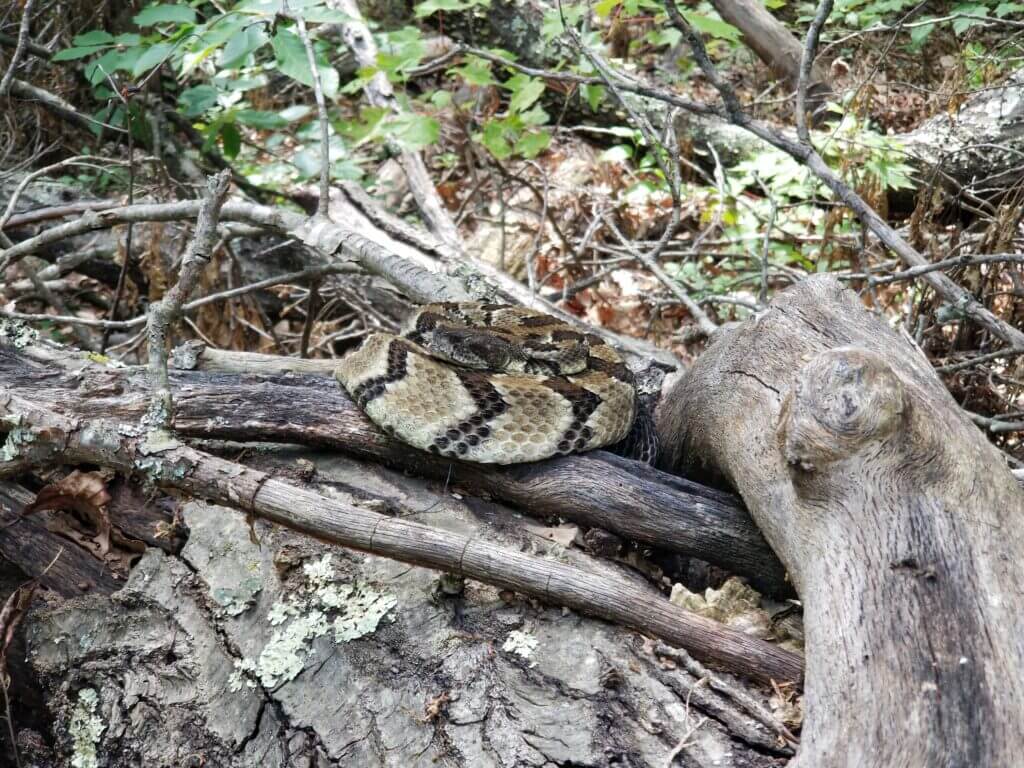
The timber rattlesnake’s camouflage colors let it blend into the forest floor and other surroundings. 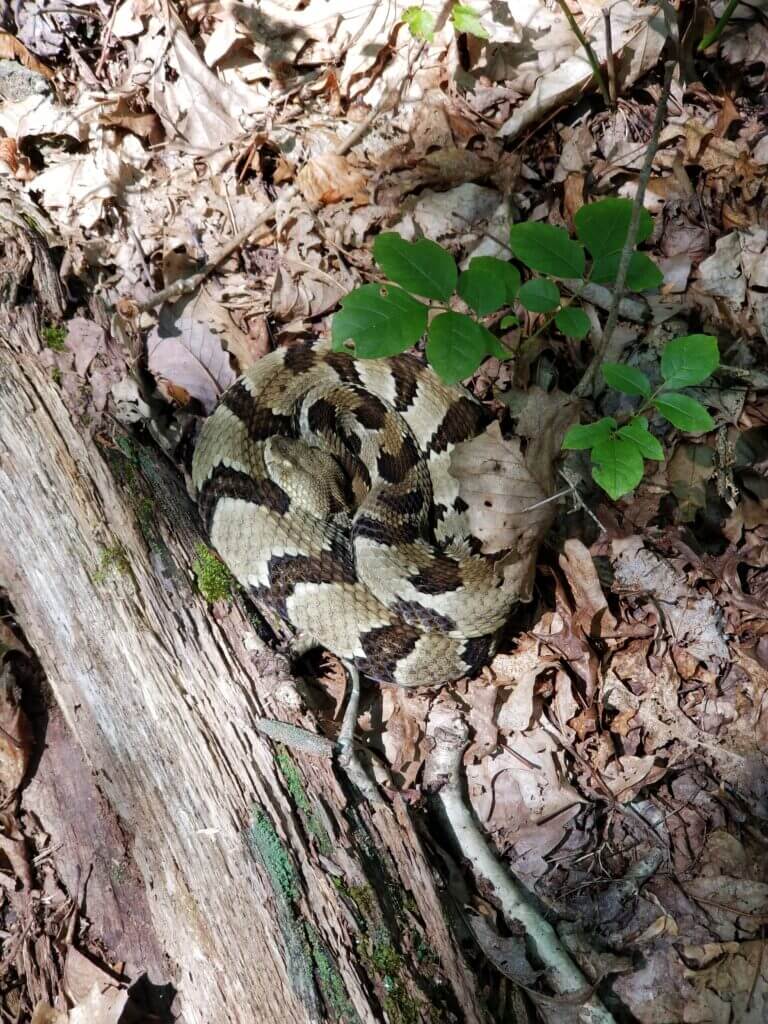
A timber rattlesnake in ambush posture.
During the official survey period, 485 observations were recorded. Observations included new areas, and some historically populated areas did not report any current data—which could signal an expansion or retraction of the population in West Virginia.
“We don’t really know yet and will need follow-up surveys in these particular areas to verify any changes,” Oxenrider says. Some hot spots of high human–animal interactions were reported, but these did not necessarily mean the existence of large rattlesnake populations, because multiple people could have been reporting the same animal.
Data obtained from this survey will be used to develop a conservation plan for the state, guiding outreach in public areas. “The people who reported these sightings play a vital role in our conservation efforts. We now know where to begin targeting our outreach and educational efforts. Whether through signs or brochures, we want people to know how to enjoy the outdoors safely in rattlesnake country.”
Tracking “Timbers”
The citizen science project also triggered research at Marshall University in Huntington. Jayme Waldron, an associate professor in the school’s Department of Biological Science, is heading up a three-year study seeking more effective ways to move rattlers that show up in high-use recreation areas. “I’ve been doing the same sort of study with the eastern diamondback rattlesnake in South Carolina, so when observational data in this state showed numerous areas of human rattlesnake interactions, a field study seemed a perfect fit for the ‘timbers’—timber rattlesnakes—here in West Virginia.”
Last year approximately 60 timber rattlesnakes, male and female, were captured, weighed, fitted with external transmitters near their rattles, and released back into their home ranges.
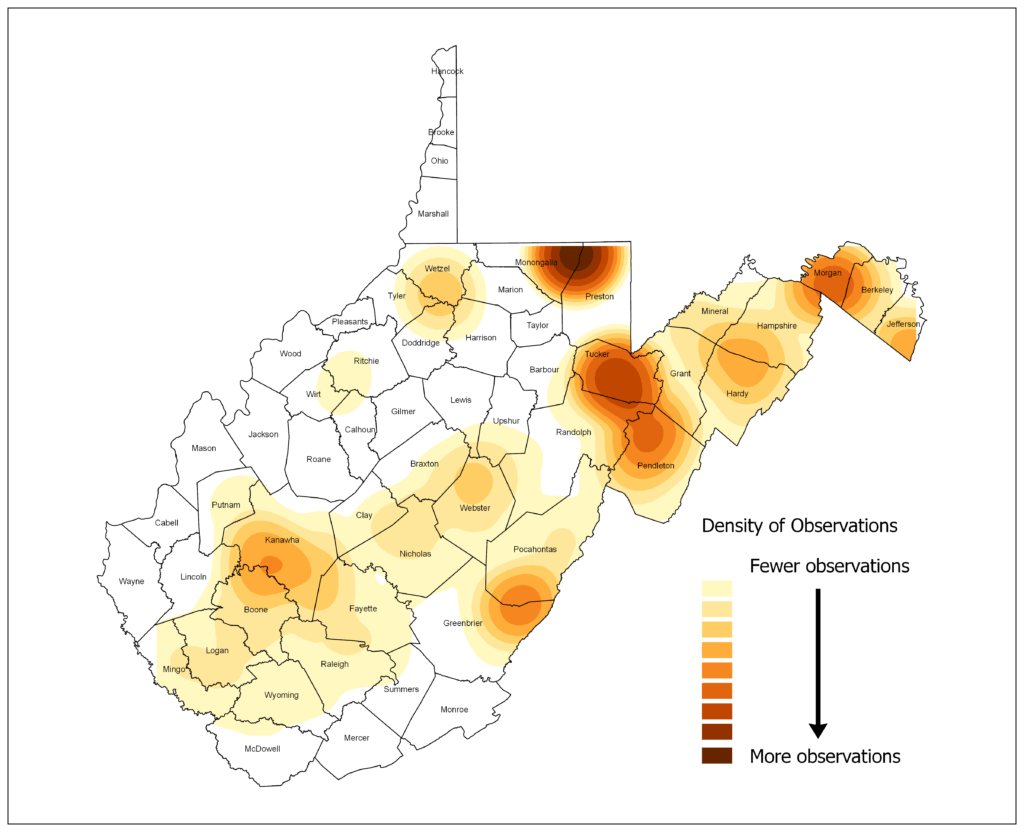
“The study involves three phases. This past year we tracked their movements and learned the size of their home ranges, so everything was normal for them,” Waldron says. “This year when they come out of hibernation, usually in May, they’ll warm up, shed their skins, and forage.” After giving the snakes about a month to forage, Waldron’s team will move them to randomly assigned areas away from people. Her team has designated three groups for each field area: control groups that will not be moved, groups that will be relocated within the same home range, and groups that will be translocated, or moved completely outside of the home range.
After relocation is when this study will get interesting, Waldron says. The people monitoring the snakes will be very busy, tracking every day, and she anticipates the translocated group will probably move a lot because they’re in strange territory and may move great distances trying to orient themselves and get home. She’s curious to study the strong homing behavior of the timber rattlesnakes, whether they will return, and how they will deal with the stress of being in a new landscape.
“We don’t know what will happen,” Waldron says. “The first year of the study we saw zero mortality as we tracked the timbers in their home range. During the second and third years, we do expect to see some mortality, but will it be greater than normal? We just don’t know.” The snakes that are moved will have to learn new territory and how to forage in their new settings, which could prove very stressful for them. Some may even starve. Researchers will retrieve each snake twice each year, weigh it and assess its general body condition, and re-release it.
Next year, the third and final year of the study, the researchers will record additional data and seek the answers to additional questions. “Across the country, people move rattlesnakes all the time,” Waldron says, “but scientists don’t necessarily know what happens to them after they are moved.” That’s exactly what she hopes to find out from this study.
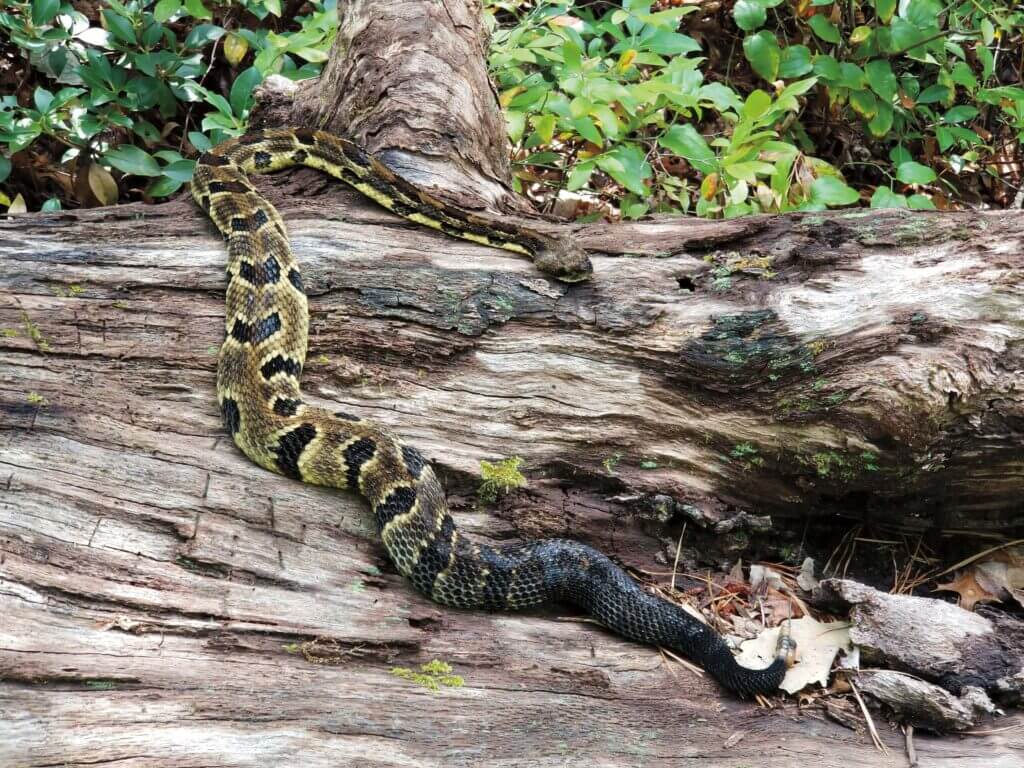
Waldron is passionate about her work. “I love rattlesnakes. They are beautiful animals, and so misunderstood.” We revere various other predator species, she says, but the shy rattlesnake is the ultimate underdog in the predator world. “This citizen science project was gold. It helped us embark upon this study, which will deliver information to DNR that enables them to better manage the timber rattlesnake population. It’s a win-win for everybody.”
The timber rattlesnake is disappearing from its historical range. As it struggles to survive, the beautiful, timbered mountains of West Virginia provide an important refuge for this underappreciated denizen of the wilderness.
Tips for Rattlesnake Country and How you Can Help
- Be observant, stay on the trail when hiking, and watch where you put your hands and feet.
- If you see a rattlesnake, do not attempt to handle it; give it distance and respect. It can strike at up to half its body length when attacked or threatened, so give it a wide berth.
- If a snake is found near your home, use harassment techniques that will not harm the snake. Spraying it with a jet stream from your garden hose will encourage it to move on. Gently touching its tail with a long pole is also an effective strategy. Studies show they usually do not come back.
- Make your yard unattractive to rattlesnakes by mowing your grass and clearing away piles of logs and sticks. Minimizing the presence of rodents helps, too.
- Talk with others about the critical role rattlesnakes play in our ecosystem.
- Do not kill rattlesnakes.
- Continue to report sightings at http://www.wvdnr.gov/rattlesnakereport/, so biologists and conservationists can better manage populations in the state.











